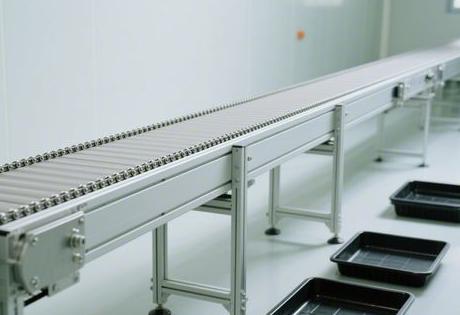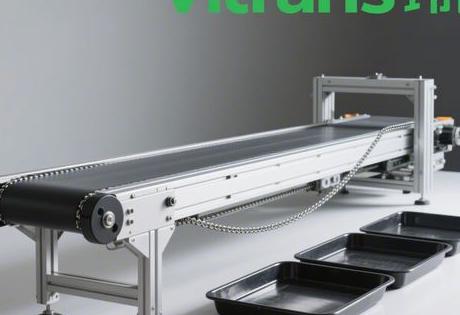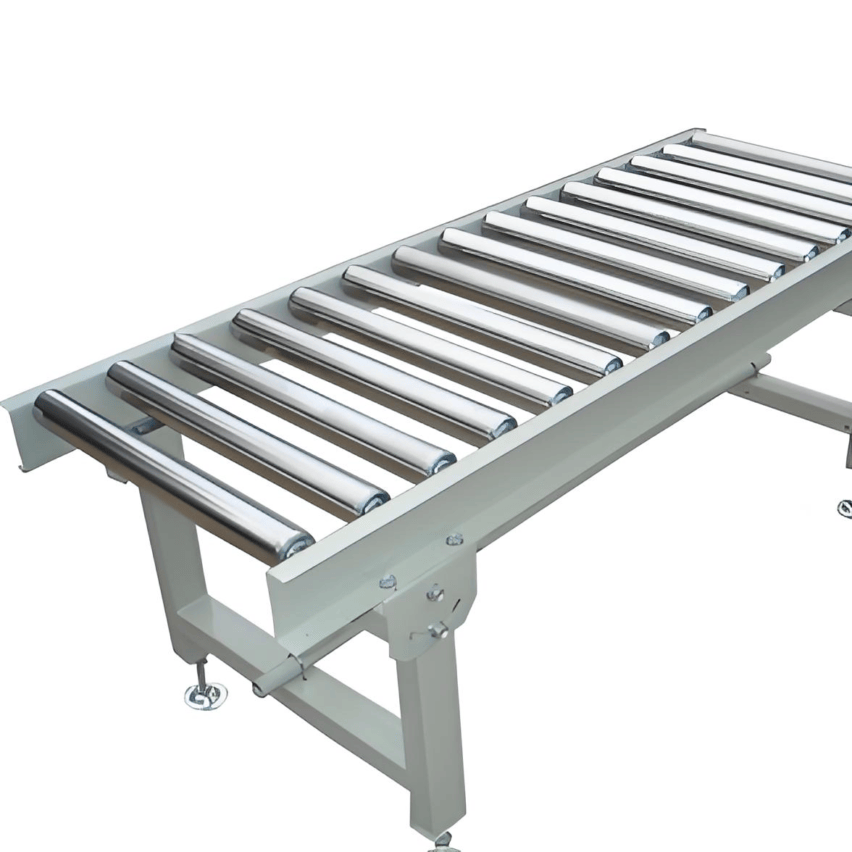一、核心技术:Heavy Duty Speed Chain的力学重构
velocity superposition principleIt is the core competence of the multiplier chain:

- Internal chain roller(diameter d) in contact with the guideway, creating a base velocity V₁
- External Chain Roller(Diameter D, D>d) Additional velocity due to friction with the work plate
By means of the formulaTotal V = V₁ x (1 + D/d)When D=2d, the speed of the pallet can be up to 3 times the speed of the chain. This design is required in 400kg heavy load scenarios by theSteel Roller Reinforcement(alternative engineering plastics) andDouble sprocket synchronised drive(Centre distance error ≤±0.5mm) to balance speed and stability.
Heavy Duty Adaptive Retrofit::
Measured data from an engine assembly line at an automotive plant:

- adoption3x speed chain + thickened chain plate(Pitch 50.8mm), load capacity increased to 500kg.
- Roller surfaceLaser microstructuringThe coefficient of friction is increased by 40% to avoid slipping.
- Bend radius ≥ 800mm (500mm for standard line) to prevent centrifugal force from deflecting the workpiece
II. Key challenges and breakthroughs in heavy-duty design
1.Chain and track reinforcement
assemblies Light duty programme 400kg heavy duty programme Effectiveness Enhancement Chain material engineering plastics Carburised steel (surface hardness HRC 45-50) Abrasion resistance↑300% Type of track Standard aluminium alloy profiles Aluminium profiles with rail reinforcement Deformation resistance↑200% tensioning device spring-loaded Hydraulic servo tensioning + tension sensor Sag control ≤1% Pitch Source of data: 2.5x speed chain steel roller with rail programme with a permissible load of up to 5.88kN (approx. 600kg). 2.Powertrain upgrades
- Motor power calculation: Based on the formulaP=μQv/(η×1000)(μ friction coefficient, Q load, v speed, η efficiency), 400kg load needs to use ≥ 5.5kW inverter motor
- activation protectionS-shaped acceleration and deceleration curves (acceleration ≤ 0.3m/s²) to avoid chain breakage due to heavy load inertia impact.
- Lubrication systemAutomatic injection of high temperature chain oil (100℃ viscosity ≥46mm²/s) every 500 hours to ensure the stability of -10℃~150℃ working conditions.
III. Systems integration: from conveyance to intelligent collaboration
1.Modular Function Expansion
- jack-up transplanter90° wire change, positioning accuracy ±0.1mm when loaded with 400kg.
- Electrostatic adsorption work plate: ±5000V fixed metal workpiece, displacement <0.05mm under vibration environment.
- Double return layoutVertical Space Utilisation 200%, a factory in Changzhou achieved the original 500m2 capacity in a 300m2 workshop.
2.Three-tier architecture of the control system
plaintextmake a copy of[Device layer]: High-precision photoelectric sensor (±0.5mm positioning) + temperature monitoring │ [Execution layer]: MES dynamic scheduling (automatic speed reduction to 1.5 times speed in heavy load section) │ [Decision layer]: AI load prediction model (failure rate reduced by 70%)Application Cases: Suzhou Battery Factory reduced the delivery time of 400kg battery boxes to 90 seconds per piece by using this architecture.
IV. Industry Landing: Empirical Efficacy of Heavy Duty Scenarios
Construction Machinery Assembly Line (Xugong Group)
- Conveying large hydraulic valve blocks (single piece weight 380kg)
- Differential sprocket set designCompensation for centrifugal force in turns, speed fluctuation <5%
- Shift production capacity from 80 to 142 pieces, workpiece damage rate to zero
New Energy Battery Module Line (Ningde Times)
- Continuous conveying of 400kg battery packs
- Fully enclosed dust-free track: Dust Pollution Reduction 90%
- Ceramic coated rollers + anti-static tray to eliminate the risk of sparks
V. Future evolution: the double revolution of green and smart
Magnetic Levitation Drive Technology
Contactless transmission in the test:
- Energy consumption reduced by 40% compared with conventional motors
- Completely eliminates metal dust caused by chain wear.
Digital twin pre-commissioning
- Preview of a heavy-duty line operation in the virtual environment of the Qingdao plant:
Thermal deformation compensation algorithm for 12m chain runout <0.1mm
New model introduction cycle time from 14 days → 3 daysBio-based Composites
DuPont mass production by 2025Polyamide rollers::
- Carbon Footprint Reduction 53%
- Abrasion resistance 3 times higher than engineering plastics
Ask Yourself: Core Concerns with 400kg Speed Chains
Q1:Do I have to choose 3 times speed chain for 400kg load?
A.clogged--Real growth rates are affected by frictional losses:
- 2.5 times the speed chain measured 2.3 times the speed increase (light load ≤ 200kg)
- 3 times the speed chain measured 2.7 times faster (heavy load ≥ 400kg)
It is recommended to choose 3x speed chain for heavy load scenarios and reserve 20% safety margin.Q2: How to solve the chain slippage during heavy load startup?
A: Triple defence and control:
- Hydraulic tensioning deviceDynamic compensation of chain elongation
- Roller surface micro-groove treatmentIncreased coefficient of friction
- S-curve start(acceleration ≤ 0.3m/s²)
Q3: Irreplaceability compared to AGV?
A: The multiplier chain is inContinuous flow heavy-duty conveyingThe advantages are significant:
- Energy consumption is only 1/4 of that of AGV systems
- Synchronised dynamic assembly capability (AGVs need to be parked)
- Low Maintenance 60%
When the manufacturing industry pursues the balance between "heavy load" and "high speed", 400kg speed chain conveyor line is the best choice.Measured energy consumption reduction of 34% at 2.7x speedThe data proves it.Innovative iterations of mechanical structures, remains the cornerstone for smart factories to achieve a win-win situation in terms of reliability and economics.













